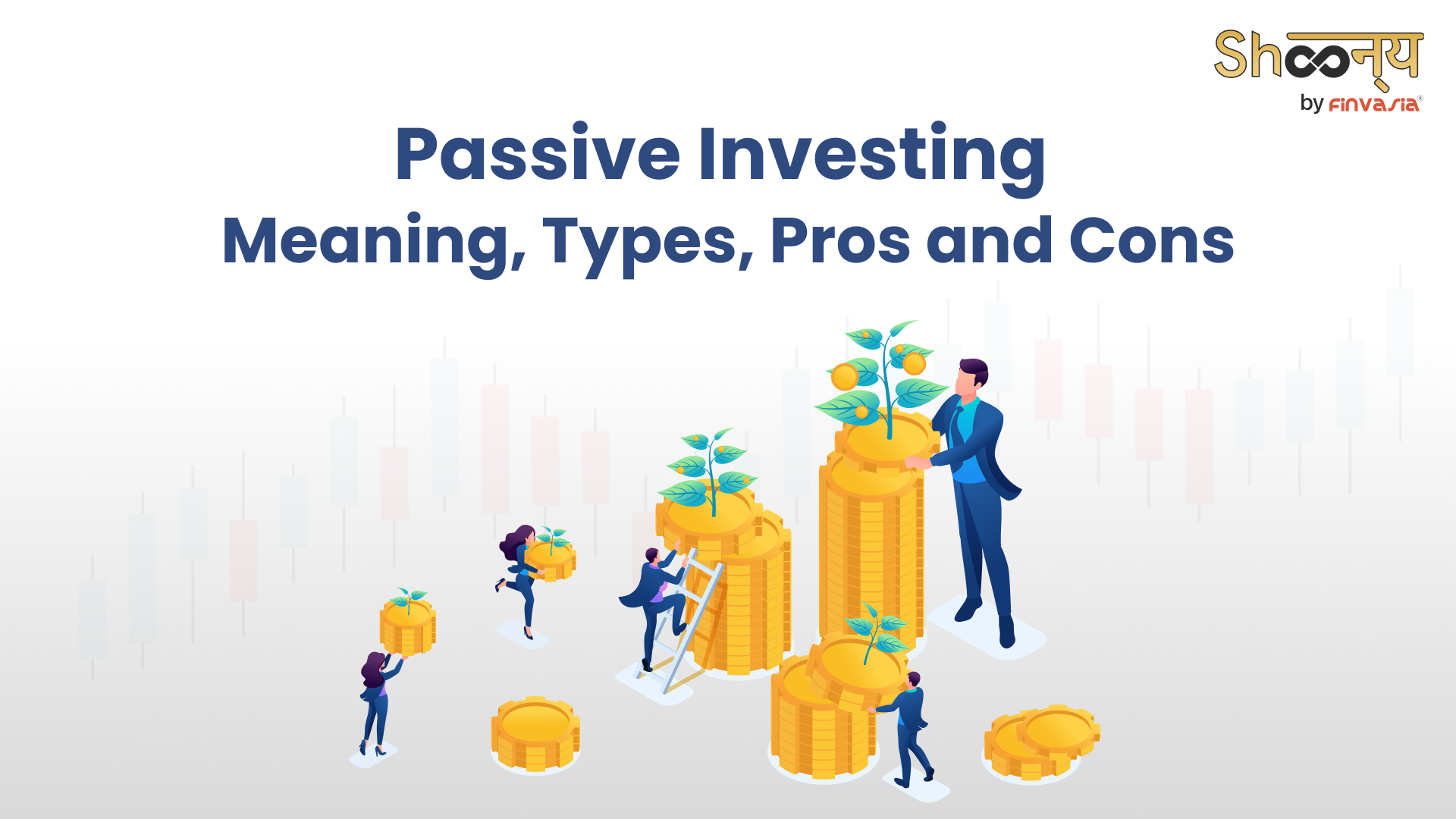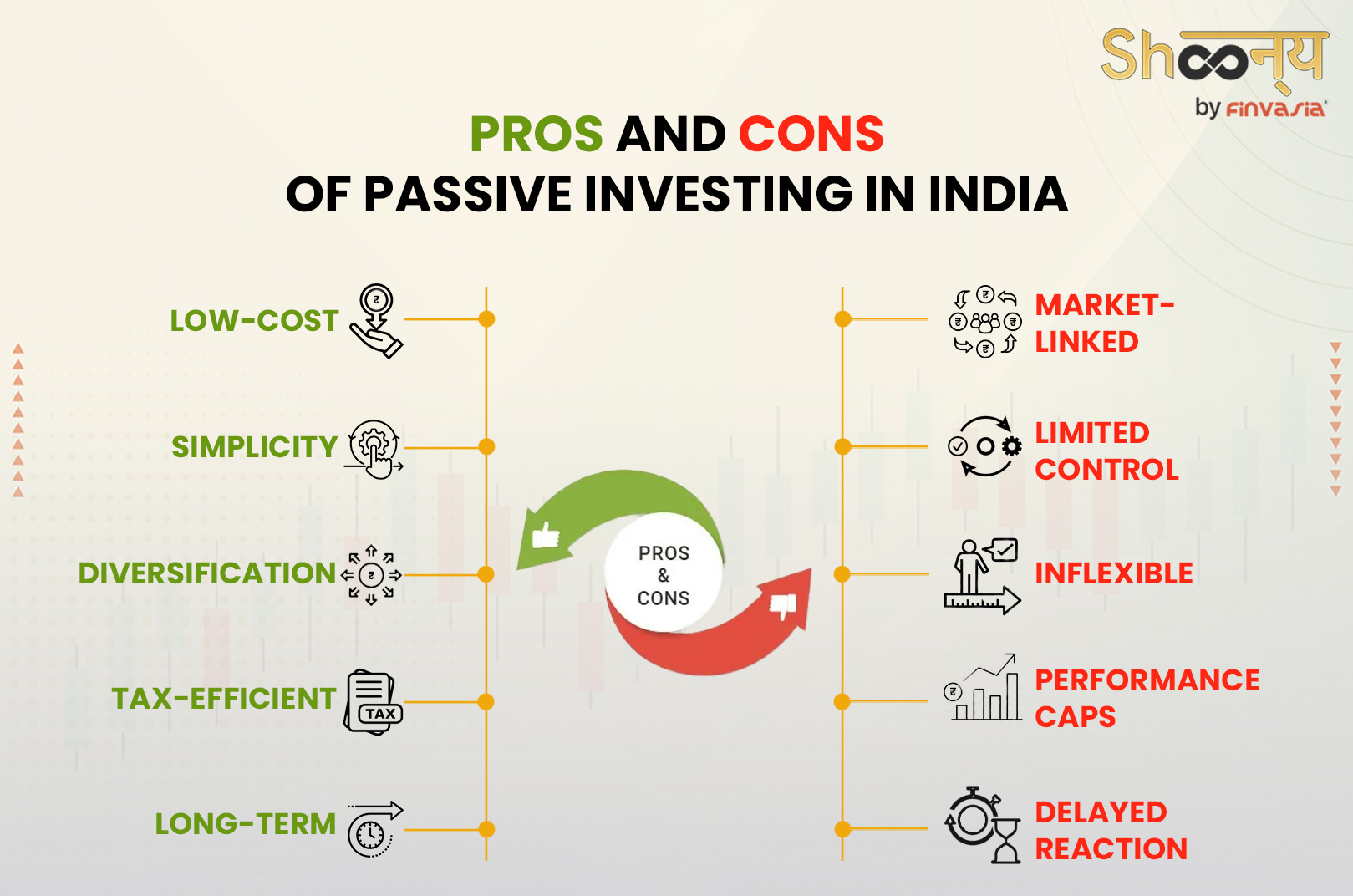Passive Investing| Meaning, Types, and Difference Between Passive and Active Investing

Most of us nowadays are looking for additional sources of income. One common avenue we consider is investment. When it comes to investing, there are two main approaches: active and passive. Active investing means when you try to beat the market, while passive investing aims to mirror the performance of a specific market index. How do you decide which strategy is suitable for you: active or passive investment? And why do most people begin with passive investing?
Let us understand it today!
Understanding Passive Investing
Passive investing involves putting your money into investment funds that track a market index, like the BSE Sensex or NIFTY 50 in India. You’re not trying to beat the market by picking individual stocks.
Instead, you’re aiming to match the performance of the index itself.
It’s like riding the wave of the overall market rather than trying to catch specific waves.
In simple terms, when you passively invest, you’re not trying to outsmart the market by constantly buying and selling stocks.
Instead, you’re playing the long game.
You buy into a fund, and your investment moves up or down with the market as a whole. This strategy is less about trying to time the market and more about steady, long-term growth.
What is a Passive Investment Strategy?
A passive investment strategy is all about simplicity and low costs.
You invest in funds like index mutual funds or exchange-traded funds (ETFs) that aim to replicate the performance of a particular market index.
- Since these funds aren’t actively managed by a team of experts, they typically have lower fees compared to actively managed funds.
- With passive investing, you’re spreading your risk because you’re investing in a wide range of stocks that make up the index.
This diversification helps cushion against the ups and downs of individual stocks.
Plus, you don’t need to spend a lot of time researching and analyzing individual companies.
Instead, you can set it and forget it, letting your money grow steadily over time as the market grows.
Now, before you decide to begin with passive investment, here are some additional things you must know!
Pros and Cons of Passive Investing in India

What are the Pros of Passive Investing?
Here are some advantages of a passive investment strategy:
- Easy to Understand
Passive investing is a simple approach.
You invest your money in a fund that tracks a market index, so you don’t need to be an expert to get started. - Lower Fees
Since passive funds don’t require active management, they usually have lower fees compared to actively managed funds. - Diversification
With this type, you can spread money across many different companies or assets within the index. This reduces the risk of losing all your investments if one company performs poorly. - Consistent Returns
By tracking a market index, passive investments aim to match the market’s performance over the long term. While there may be fluctuations in the short term, historical data shows that markets generally trend upward over time. - Time-Saving
You don’t need to spend time researching individual stocks. Once you’ve chosen your passive investment strategy, you can sit back and let your money grow.
What are the Disadvantages of Passive Investing?
Let us take a look at some downsides of passive investment strategy:
- Limited Growth Potential
Since passive investing aims to match the market’s performance, you might miss out on potentially higher returns. This is possible for active investors as they can pick individual stocks or time the market. - No Control Over Holdings
When you invest in a passive fund, you’re essentially buying whatever the index holds. This happens regardless of whether you agree with all the companies included.
This means you have no say in which companies you’re investing in. - Underperformance in Bull Markets
In strong bull markets where certain sectors or stocks outperform the broader market, passive investors might miss out on these opportunities since they’re invested across the entire market index. - Dependency on Market Performance
A passive form of investing relies on the market’s overall performance. If the market experiences prolonged downturns or stagnation, passive investors may see slower growth or even losses in their investments.
Types of Passive Investing
If you plan to pursue the passive form of investing, here are different types:
a. Index Funds:
Index funds aim to imitate the performance of a specific market index, like the Nifty 50 or the BSE Sensex. They have lower expense ratios than actively managed funds because they need minimal management.
b. Exchange-Traded Funds (ETFs):
ETFs, similar to index funds, trade on stock exchanges like individual stocks. They offer flexibility in buying and selling throughout the trading day at market prices. ETFs also provide diversification and low-cost exposure to various market indices.
When considering passive investment, it’s important to understand the associated costs.
Unlike active investing, where fund managers select stocks or bonds, passive investment strategy relies on allowing a particular index to determine which securities to trade.
This means there are no additional expenses for research analysts, although even passively managed funds will charge fees. Therefore, it’s essential to investigate the costs associated with different types of funds before investing.
Active vs. Passive Investing
Active investing involves picking and choosing individual stocks or other assets with the goal of outperforming the overall market.
It requires frequent buying and selling based on research and analysis.
Passive investment strategy, on the other hand, means investing in funds that track market indexes like the NIFTY 50 or BSE Sensex.
You’re aiming to match its performance over time.
In active investing, you’re making constant decisions and adjustments, which can be time-consuming and may incur higher fees.
Passive investing, however, is more about a set-it-and-forget-it approach, with lower costs and less effort required.
| Active Investing | Passive Investing |
| Involves selecting individual stocks or assets. | Involves investing in funds that track market indexes. |
| Requires frequent buying and selling based on research. | Not aimed at outperforming the market; rather, it matches its performance. |
| Aims to outperform the overall market. | Requires less effort and time as it follows a set-it-and-forget-it approach. |
| Often involves higher fees due to active management. | Typically, it has lower fees compared to active investing. |
Active vs Passive Investing Example
Active investing involves picking specific stocks.
For example, you could invest in individual companies such as Tata Consultancy Services or Reliance Industries, which involves making decisions based on company performance and market trends.
Passive investment, on the other hand, would be putting your money into an index such as the HDFC Index Fund or the SBI Nifty ETF.
You’re essentially investing in the entire market rather than individual companies.
What Kind of Returns Can You Expect from Active vs Passive Investing?
Activ investment aims to drive up returns by pursuing frequent trading, but these returns may diminished by the fees associated with professional management. This remains affected by frequent buying and selling.
Passive investment focuses on achieving solid long-term returns by reducing buying and selling activity. However, it’s not likely to outperform the market and generate significant returns in the short run.
On the other hand, active investment has the potential for higher returns, but it also entails greater risks compared to passive investment.
Which is Better: Active or Passive Investing Strategy?
Both active and passive investing strategies have their own benefits and drawbacks, so there isn’t a one-size-fits-all answer to which is better. It depends on individual preferences, goals, and risk tolerance.
Beginners often lean towards passive investments for its simplicity and lower fees.
FAQs| Passive Investing
Passive investing carries market risk due to long-term strategies with minimal trading.
Five advantages of passive investing include lower costs, simplicity, diversification, tax efficiency, and consistent long-term returns.
To start passive investing, consider investing in index funds or ETFs aligned with your financial goals and risk appetite.
______________________________________________________________________________________
Disclaimer: Investments in the securities market are subject to market risks; read all the related documents carefully before investing.








